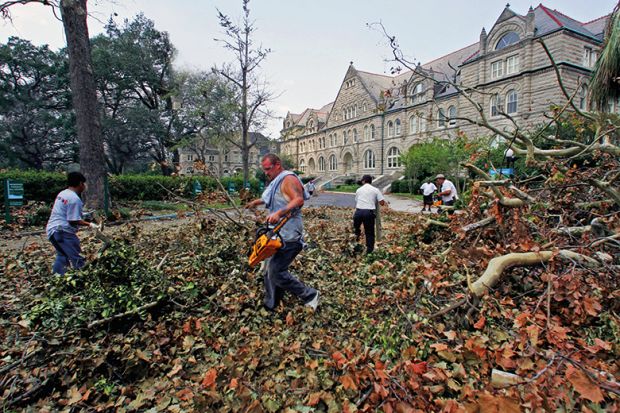The US has a growing club of universities that have survived devastating hurricanes. One hard-earned result: an expanding list of examples of how to rebound and prosper.
The leaders of several such institutions gathered in New Orleans – a city almost destroyed by Hurricane Katrina in August 2005 – and shared what they learned.
Some of the biggest lessons were to decide quickly to rebuild; to keep staff paid and students enrolled even as debts mount; not just to make emergency plans but to test them thoroughly in advance; not to rely on the government; to ignore the lawyers and talk to the parents; and to prepare for mental health challenges long afterwards.
“Resilience,” said Scott Cowen, a professor of business at Tulane University in New Orleans – who was its president when Katrina hit, leaving it underwater for two months – “is not just a word we should use casually; it’s a word we should understand deeply and broadly.”
Professor Cowen – along with the heads of the storm-ravaged University of Houston and University of the Virgin Islands – recounted his recovery story at the annual conference of the Association of Public and Land-grant Universities.
After relocating to Houston with top Tulane staff, Professor Cowen said that he made three significant decisions in the first 24 hours: to restart the university in the coming spring semester; to pay staff during that time despite having no income; and to ask colleges around the country to admit Tulane students for free for the rest of the semester and then return them afterwards.
“Those immediate decisions you make are often the most critical, and the communications you make are often the most critical,” Professor Cowen said. The call to reopen was especially daring given high-level talk in Washington about whether it made any sense to rebuild New Orleans, given that half of it is already below sea level and will be well beneath that in a few decades.
“We absolutely had no idea whether we could open up at that time, or whether we would ever open up,” he added. Tulane did reopen the following January, but it took another four years before it regained its full first-year enrolment of 1,600 students.
Houston’s chancellor, Renu Khator, said that she too pushed her executive authority and ignored powerful advice after her city was hit by Hurricane Harvey in August 2017.
Putting a priority on the people, she won back staff – many with their own homes under water – by waiving rules to let them bring their children to campus and eat for free in the university’s dining facilities. She even had to override university lawyers who objected to water rescues taking place before they could check legal certificates on participating boats.
“I told my attorney it’s my job to make academic decisions, and it’s your job to go and defend me,” Professor Khator said.
David Hall, president of the University of the Virgin Islands, said that he too made an immediate commitment to reopen after being hit by back-to-back Category 5 hurricanes, Irma and Maria, in September 2017.
As part of that, Professor Hall promised all students that they would “be held harmless”, with no financial penalty if they decided to withdraw. At the same time, he promised “to do all we could to save the year and save the semester” for those who remained.
About 350 students left during that semester, 200 of them immediately, said Professor Hall. The two-campus institution still has only about 2,000 students, several hundred short of its pre-hurricane numbers.
The longer-term recovery may be mental health related, Professor Cowen said. Katrina killed 1,823 people and caused the population of New Orleans to fall from 480,000 to 10,000 within three weeks.
Professor Cowen described staying in the flooded city for five days before escaping by wiring a battery into a golf cart and siphoning fuel from a truck to reach a rescue helicopter.
He had to fire four of his top 12 administrators in that first week in Houston. “They were not capable of dealing with this situation,” he said. “They were wonderful people under certain circumstances, but not under others.” Even harder, Professor Cowen said, was the need to fire 1,000 staff to make the budget work as the university rebuilt its student body.
The local, state and federal government largely failed to help, Professor Cowen said. “Their strategy for it was that hope is a plan that somebody else was going to come and help us, and no one helped us,” he said.
Four years later, Professor Cowen added, he was diagnosed with post-traumatic stress. “I thought I was fine,” he said. “I was not fine.”
POSTSCRIPT:
Print headline: Weathering the storm: how to rebuild after a disaster
Register to continue
Why register?
- Registration is free and only takes a moment
- Once registered, you can read 3 articles a month
- Sign up for our newsletter
Subscribe
Or subscribe for unlimited access to:
- Unlimited access to news, views, insights & reviews
- Digital editions
- Digital access to THE’s university and college rankings analysis
Already registered or a current subscriber? Login








